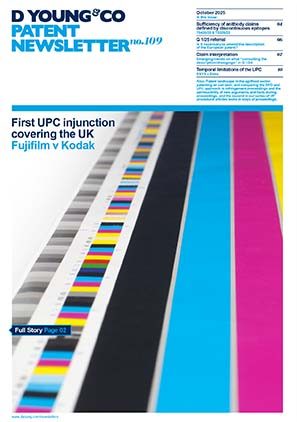“Forget social media, I can talk to my washing machine!”: patenting computer technology in wider product markets at the EPO
Mention computing or software technology and it’s easy to think about today’s most popular social media apps, productivity tools or artificial intelligence (AI) assistants. But what about the effects of computing technology on other products? Whether we’re talking home appliances, power tools or health and beauty gadgets, innovators are harnessing modern computing power to help deliver products with improved performance, functionality and efficiency.
This article discusses some of the ways computing technology may be used to enhance such products and how patent protection might be obtained for such technology at the European Patent Office (EPO).
Computer-implemented technology at the EPO
A challenge with patenting computer-implemented technology is that, often, the computer hardware which implements the technology is itself not new (for example, it may be an off-the-shelf “system on a chip” (SoC) or similar). What can be new, however, is what the hardware is controlled to do by way of software. This is known as a computer-implemented invention (CII) at the EPO.
The EPO has a well-established approach to assessing the patentability of CIIs. Central to this approach is the determination of whether or not the new thing the hardware is controlled to do provides a “technical effect”. Only features providing a technical effect may be taken into account in the assessment of inventive step with respect to the prior art. Demonstrating the presence of a technical effect is therefore essential if a European patent for a CII is to be obtained. We will therefore discuss some examples of how a technical effect might be demonstrated for CIIs associated with different aspects of a product.
Improved mechanical operation
One way of demonstrating that a CII has a technical effect is to show it produces an output usable for controlling a product to mechanically operate in a new or improved way.
For example, it is becoming increasingly common for the action of a mechanical component to be controlled by a suitably programmed chip which takes input data from sensors (for example, measuring temperature, pressure, torque or the like) and processes the input data to generate output data (for example, data indicative of a voltage) for controlling that mechanical component. This allows finer tuning of the action of the mechanical component to different operating or environmental conditions than would otherwise be possible, thereby leading to improved safety, performance or efficiency.
This principle has helped enable everything from washing machines which improve efficiency by automatically adjusting the amount of water used based on the weight of the laundry, to electric toothbrushes which improve user safety by cutting out or slowing down if a user applies too much pressure to their teeth or gums with the brush.
The steps the chip are programmed to carry out to enable such improvements are an example of a CII, and the resulting improvements to safety, performance or efficiency will often be considered technical effects by the EPO.
Innovative controls
Other CIIs that may have a demonstrable technical effect are those enabling improved ways for a user to control a device. Physical buttons, switches and dials are increasingly being replaced with touch screens or controls. There is also a growing demand for connected devices which can be controlled via an app on a user’s smartphone or via voice commands issued to a smart speaker. While the touch-sensitive, voice-processing or network hardware which enables such functionality may well be known, the CIIs which control this hardware to operate in new ways leading to easier or more effective methods of controlling an appliance may well be found to exhibit a technical effect.
One example is graphical user interfaces (GUIs). Although it will likely be difficult to patent the mere presentation of information on a screen (even if the way the information is presented is new), a CII may well be found to exhibit a technical effect if it allows a user to interact with information on the screen to control an appliance in a new way which is objectively easier or allows more accurate control (for example, of appliance operations, settings or timers). A technical effect may also be demonstrated if it enables the displayed information to dynamically change to reflect a current operating condition (such as temperature) of the appliance, for example. In a world increasingly saturated with a myriad of GUI designs, a product with a particularly effective and accessible GUI can have a big advantage over competitor products.
This principle extends to smartphone apps and smart speaker interactions too. If these are well designed to allow a user to quickly and easily get an appliance to do what they want it to do, any new and innovative CII features enabling this functionality may well exhibit a technical effect. In this case, CII protection not only for the appliance itself but also for new and innovative features of the smartphone app, smart speaker functionality and any remote CII (for example, steps executed on a server) could also be sought through appropriately drafted claims.
Machine learning and AI
With increased data generation, computational power and device connectivity, machine learning and AI are being increasingly deployed to help facilitate better device automation and efficiency. CIIs implementing machine learning are typically assessed as computer-implemented mathematical methods at the EPO. Demonstrating a technical effect therefore requires either a technical application or specific technical implementation to be shown.
Technical application relates to the purpose of the method and whether or not this is technical. For example, gathering appliance usage data for use with a machine learning model to generate targeted adverts is more likely to be seen as a “business” rather than “technical” purpose. It may therefore be difficult to demonstrate a technical effect in this case. On the other hand, using such data with a machine learning model to predict when a particular appliance is likely to be used to improve energy efficiency may well be seen as a “technical” purpose, making the demonstration of a technical effect easier.
Specific technical implementation relates to whether a CII is particularly adapted to take into account technical considerations of the internal functioning of the computer system or network which implements it. Thus, for example, if a machine learning model for processing appliance usage data has been specifically designed to execute efficiently on a particular type of hardware (taking into account the architecture and computational resources of the hardware), this may be considered a technical effect.
A further consideration for patenting CIIs using machine learning models is the indication of sufficient detail of an example machine learning model (for example, the model type and architecture) and example training data. Enough information about the model and training data should be provided in the patent application description to enable a skilled person to re-create the claimed CII without undue burden. This is to ensure that the claimed CII is deemed sufficiently disclosed by the EPO.
Machine learning models are thus further examples of CIIs which may be shown to demonstrate a technical effect.
It is noted that a single CII product may perform multiple functions associated with multiple respective technical effects. For example, a smartphone app may both process appliance usage data in a new way to predict future usage patterns for energy saving purposes and provide a new and improved appliance control interface. In this case, protection for the set of features enabling each separate technical effect might be independently pursued through an appropriate filing or claim drafting strategy.
Conclusion and further thoughts
The inclusion of new and useful CIIs is one way of distinguishing mechanically similar products in an increasingly competitive market. If a suitable technical effect can be demonstrated, European-wide patent protection for such innovations via the EPO may be possible to help protect the “creators” from the “copiers”.
There may also be other advantages to patent protection. For example, it may help attract investment and can help reduce an organisation’s UK corporation tax bill through the UK’s Patent Box scheme (thereby offsetting the cost of obtaining patent protection, sometimes many times over).
D Young & Co’s patent attorneys are highly skilled in drafting and prosecuting patent applications for CIIs with a view to covering product functionality and demonstrating the required technical effect. If you would like assistance in this area or simply to discuss anything in this article, please contact Arun Roy or your usual D Young & Co representative.

